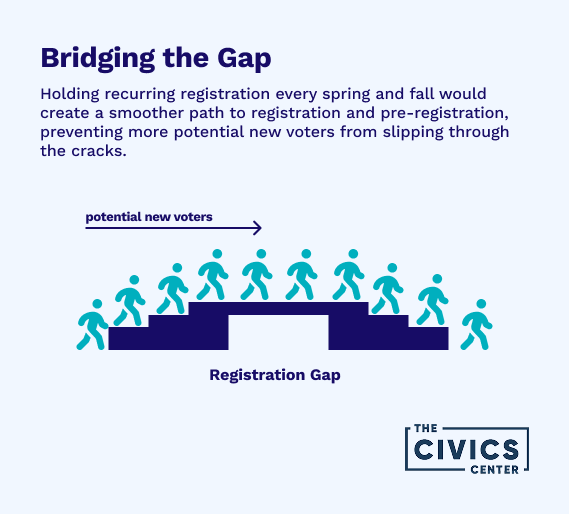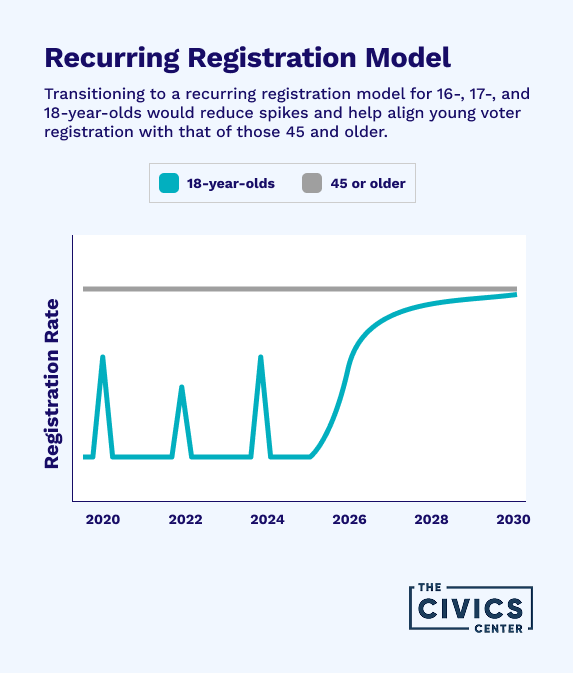How current systems fail our youngest voters
A case study on Ohio
When I tell people that high school voter registration is a democracy emergency and that our current systems are failing to find and register our youngest voters, the most frequent response I get is, “hunh, what are you talking about?” It usually sounds not so much like a genuine question, but more like a brushoff. Maybe they’re thinking it’s a tiny, disengaged group, so why waste our time?
If I’m lucky, I can get to the assumptions behind the reaction. Don’t I know about Motor Voter and online voter registration? These systems are supposed to be low-cost and efficient. Colleges seem to be dealing with it. So, can I please stop going on and on about high school voter registration and the urgency of students and educators working together to host drives in their schools?
This same pattern has been going for years. See our blog for evidence that we’ve been raising alarm bells since 2019.
But I’m an optimist. We have about two months to go before 4 million high school Seniors will walk across a stage and receive their diplomas, so if we act now and help them register to vote before they do, we can increase the likelihood of free and fair elections in 2025, 2026 and beyond.
To illustrate the problem and solution, we’ll use a case study on Ohio.
Imagine you are a high school student in Cincinnati. You are 16 years old, and your birthday is July 4, 2008. Which means you will be 18 and eligible to vote in the 2026 midterms. But will you be registered in time? Let’s look at the reality on the ground:
If you are like 36,000 (23%) of other Ohioans your age, you won’t get a driver’s license by the time you turn 18. In your case, the Ohio Bureau of Motor Vehicles will not help you to register since you have no other reason to go there.
The state’s online voter registration system also will not help you, because you need a driver’s license or state ID to use it.
Ok, so what about the 36% of Ohio 16-year-olds (~57,000 out of 156,000) who do get their driver’s licenses at the age of 16? Congratulations. You are about to get a dose of freedom.
But you’re not going to get registered to vote when you go to the Bureau of Motor Vehicles, however, because you are not yet old enough to register to vote in Ohio.
Today, only those who will be 18 by November 5, 2025, are old enough to register to vote in Ohio.
Ok, but what about when you renew your license?
That won’t happen until 30 days before you turn 21. So, in your case, since you were born on July 4, 2008, you can renew your license starting in June 2029. Your driver’s license renewal opportunity will not help you get registered for the 2026 midterms or the 2028 presidential election.
If we combine the young people who do not get driver’s licenses at all with those who get a license at an age when they are too young to register to vote, we’re looking at about 60%, or 92,000 of Ohio’s current 16-year-olds, who are simply missed by the state BMV.
What about college voter registration programs? Only 48% of Ohio high school graduates go on to 2- or 4-year college programs. Voter registration programs aimed at college campuses, as important as they are, miss more than half of the state’s young people.
This is not an effective voter registration system.
We can observe the impact of such restrictive policies with data visualizations.
Only 51.6% of 18-year-olds were registered to vote in Ohio at the time of the November 2024 Election, one of the lowest rates of states we studied, and representing a 27.6 percentage point gap compared to voters ages 45 and above.
Since our current systems are not working, we essentially have a reactive, episodic model of voter registration, with campaigns in even-year elections doing their best to make up for baseline low levels of registration.
It looks like this:
The low levels between elections show that young people are falling through the cracks in the system. It looks like this:
At The Civics Center, we’re on a mission to make voter registration part of every high school in America. In practice, that means we’re working to build an infrastructure by reaching out to and engaging teachers, parents, and student volunteers:
Once we bridge the gap, students won’t fall through the cracks, and we’ll have a resilient system for on-boarding new voters into our democracy, as soon as they are old enough, year after year. We call this a recurring registration model, and it looks like this:
When students are active leaders of and participants in, voter registration efforts at their high school, they are learning to become agents of their own political futures. When high school students run drives twice per year, every year, it means their peers will have been given the opportunity and support to register to vote 8 times before they graduate. And they will have opened the door to real world conversations about democracy, power, and their role in making the change they want to see in their communities.
The results look like this:
Without a model of recurring outreach and engagement, we are on a downward pathway again with the youngest registered voters turning 19 and aging out of the 18-year-old category at a much faster rate than they are being replaced by new 18-year-old registrants. The registration rates for 18-year-olds rose as the voter registration deadline approached in Ohio and has been decreasing dramatically since the deadline and Election Day.
Without appropriate investment in a recurring registration model, there is every reason to believe that registration rates for 18-year-olds will revert to a baseline of less than 25% before beginning a climb back up as the midterms approach. But since Ohio barely got half of its 18-year-olds registered in time for a high-profile presidential election, the rate at the midterms is likely to be even lower than that.
Another way to visualize the problem is by comparing current registration rates for 18-year-olds with the rates of older voters on a county-by-county basis. It looks like this:
Doing the same thing over and over again and expecting a different outcome may not be the wisest choice. We’re not trying to pick on Ohio. We see this same phenomenon happening in states across the country.
That’s why we’re calling it a democracy emergency.
The issue is not receiving the attention it deserves, and a workable solution – high school voter registration – is not receiving the investment it deserves.
The work and the investment need to happen now if we are to have any chance at seeing an improvement over 2024’s low rates. And if we believe it’s on us to help young people get in the game with long-term solutions (and not simply short-term tactics for political gain) then the time to start is now.
Please help us by sharing this important fact: if young people are not registered, they are not in the voter file that candidates and campaigns use to communicate with voters. Especially in smaller, low-budget state and local races, candidates and campaigns simply do not have time and resources to find them and address their concerns.
So if you have been looking for a meaningful and concrete step you can take to strengthen our democracy now and help make sure students know that they have a right to expect and to participate in free and fair elections in 2025, 2026, and every election going forward, we hope you’ll make a commitment now, either by making a donation or downloading our volunteer toolkit and getting started with outreach to your network.
And if you are a high school student or educator, even better. You can get trained now to hold a voter registration drive in your school this spring as part of Cap, Gown & Ballot, ensuring 4 million high school Seniors are registered and ready to vote before stepping into their futures.
Let’s go!
If you want to be part of turning around the story of low youth participation, please donate today:










